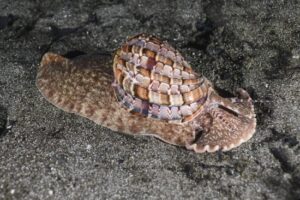The Lembeh Strait is famous for its critter filled muck diving, but in recent years it has become increasing well known for blackwater diving.
Blackwater is a type of night dive conducted in open water. A downline is hung from a buoy and bright lights are attached to it which draw in the plankton. As a diver, you slowly circulate around the line, checking out every object in your torch beam, hoping it might be a pelagic octopus, a larval crustacean or a juvenile fish, with outrageous adaptations to living in open water. The downline might drift several kilometres during the dive, but since you drift with it, there is no feeling of current at all. These are very relaxing dives, where you feel like you are suspended in a thick soup of life, rather than diving in open water.
The reason these dives are fascinating is just about every species in the sea has a pelagic larval stage. When the adults spawn, the eggs don’t hatch and immediately settle down to life with the adults, but instead grow on and disperse as part of the plankton. Here, the demands of life are very different, so they usually look very different to adults, often more translucent to keep them hidden and with a multitude of appendages that may help keep them afloat.
The reason we make these dives at night is these animals usually descend to the depths during daylight to minimise their risk of being eaten and only ascend to the food rich surface layers under the cover of darkness. Curiously, the bright lights attract many species, and those that aren’t attracted by the lights, are attracted by the concentration of potential food. The dives are unpredictable, but the feeling of never knowing what might turn up makes them highly addictive.
Blackwater diving has been taking place since in the 1970s, but it has become a more mainstream diving attraction in the last decade with the increasing popularity of underwater photography.
Digital cameras are ideal for blackwater because they have the capacity to fire off plenty of images.
The techniques of blackwater photography are pretty straightforward in theory, this is point and shoot photography. But they are more challenging in practice, especially when it comes to getting tiny, semi-translucent creatures in the frame and in focus. More than photographic skill, I think it is the best divers who usually come back with the best images on blackwater dives. It is definitely a branch of photography that rewards great diving skills.
In terms of diving gear, it is the same as day dives, although I would always recommend a hood when diving in a concentrated soup of plankton, although there were two items I found invaluable. The first was my Genius dive computer. Blackwater dives lack any real visual reference to how deep you are, so the large, constantly backlit screen on the Genius was perfect for keeping me informed. Blackwater dives are usually the final dives of an intensive diving day, and there are many creatures luring you to explore deeper, so knowing exactly how deep I was at all times was essential. The second essential item was my much more lowly EOS 10LRZ torch. Its long battery life and focusable narrow beam was so well suited for spotting the pinpricks of light in the darkness that gave away another treasure. For photography, I want a wide beam of light as I search for the subject through my viewfinder, but to find the animal in the darkness, I really need a tight focused beam. These torches are perfect for blackwater and much less expensive than the “photographic” torches some of my buddies were finding were far less effective.
Lembeh is well set up for blackwater because it is such a photographer friendly destination, but the shallow depths of the Strait limit the diversity of blackwater subjects compared to destinations with deep ocean water close to land. One of the exciting things about blackwater is that as it is tried in more destinations, we are likely to find that some of the best locations for this type of photography are not only the classic macro photography places, but also some of diving’s grand old destinations, which are perhaps overlooked by photographers these days.
The post Lembeh Blackwater appeared first on Mares – Scuba Diving Blog.
Read MoreDiving, blackwater, diving, lembeh, Mares, ocean, photography, underwaterMares – Scuba Diving Blog


